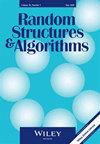大次局部树状正则图的最大切和最小分的局部算法
IF 0.8
3区 数学
Q4 COMPUTER SCIENCE, SOFTWARE ENGINEERING
引用次数: 15
摘要
给定一个k次$$ k $$的n $$ n $$个顶点的图G $$ G $$,我们考虑在多项式时间内计算近最大切割或近最小对分的问题。对于周长2L $$ 2L $$的图,我们开发了一个复杂度为O(nkL) $$ O(nkL) $$的本地消息传递算法,该算法在所有L $$ L $$‐local算法中获得了接近最优的切值。该算法以max - cut为中心,构造了一个cut值为nk/4+nP -百科- k/4+err(n,k,L) $$ nk/4+n{P}_{\star}\sqrt{k/4}+\mathsf{err}\left(n,k,L\right) $$,其中P -百科≈0.763166 $$ {P}_{\star}\approx 0.763166 $$是自旋玻璃理论中的Parisi公式的值,err(n,k,L)=on(n)+nok(k)+nkoL(1) $$ \mathsf{err}\left(n,k,L\right)={o}_n(n)+n{o}_k\left(\sqrt{k}\right)+n\sqrt{k}{o}_L(1) $$(下标表示渐近变量)。我们的结果推广到局部树状图,即在去除一小部分顶点后,其周长变为2L $$ 2L $$的图。早期的研究表明,对于随机k $$ k $$正则图,典型的最大切值为nk/4+nP - k/4+on(n)+nok(k) $$ nk/4+n{P}_{\star}\sqrt{k/4}+{o}_n(n)+n{o}_k\left(\sqrt{k}\right) $$。因此,我们的算法在这样的图上几乎是最优的。这个结果的一个直接推论是随机正则图在所有正则局部树状图中具有几乎最小的最大切和几乎最大的最小分。这可以看作是随机正则图的近拉马努金性质的一个组合形式。本文章由计算机程序翻译,如有差异,请以英文原文为准。
Local algorithms for maximum cut and minimum bisection on locally treelike regular graphs of large degree
Given a graph G$$ G $$ of degree k$$ k $$ over n$$ n $$ vertices, we consider the problem of computing a near maximum cut or a near minimum bisection in polynomial time. For graphs of girth 2L$$ 2L $$ , we develop a local message passing algorithm whose complexity is O(nkL)$$ O(nkL) $$ , and that achieves near optimal cut values among all L$$ L $$ ‐local algorithms. Focusing on max‐cut, the algorithm constructs a cut of value nk/4+nP⋆k/4+err(n,k,L)$$ nk/4+n{P}_{\star}\sqrt{k/4}+\mathsf{err}\left(n,k,L\right) $$ , where P⋆≈0.763166$$ {P}_{\star}\approx 0.763166 $$ is the value of the Parisi formula from spin glass theory, and err(n,k,L)=on(n)+nok(k)+nkoL(1)$$ \mathsf{err}\left(n,k,L\right)={o}_n(n)+n{o}_k\left(\sqrt{k}\right)+n\sqrt{k}{o}_L(1) $$ (subscripts indicate the asymptotic variables). Our result generalizes to locally treelike graphs, that is, graphs whose girth becomes 2L$$ 2L $$ after removing a small fraction of vertices. Earlier work established that, for random k$$ k $$ ‐regular graphs, the typical max‐cut value is nk/4+nP⋆k/4+on(n)+nok(k)$$ nk/4+n{P}_{\star}\sqrt{k/4}+{o}_n(n)+n{o}_k\left(\sqrt{k}\right) $$ . Therefore our algorithm is nearly optimal on such graphs. An immediate corollary of this result is that random regular graphs have nearly minimum max‐cut, and nearly maximum min‐bisection among all regular locally treelike graphs. This can be viewed as a combinatorial version of the near‐Ramanujan property of random regular graphs.
求助全文
通过发布文献求助,成功后即可免费获取论文全文。
去求助
来源期刊

Random Structures & Algorithms
数学-计算机:软件工程
CiteScore
2.50
自引率
10.00%
发文量
56
审稿时长
>12 weeks
期刊介绍:
It is the aim of this journal to meet two main objectives: to cover the latest research on discrete random structures, and to present applications of such research to problems in combinatorics and computer science. The goal is to provide a natural home for a significant body of current research, and a useful forum for ideas on future studies in randomness.
Results concerning random graphs, hypergraphs, matroids, trees, mappings, permutations, matrices, sets and orders, as well as stochastic graph processes and networks are presented with particular emphasis on the use of probabilistic methods in combinatorics as developed by Paul Erdõs. The journal focuses on probabilistic algorithms, average case analysis of deterministic algorithms, and applications of probabilistic methods to cryptography, data structures, searching and sorting. The journal also devotes space to such areas of probability theory as percolation, random walks and combinatorial aspects of probability.
 求助内容:
求助内容: 应助结果提醒方式:
应助结果提醒方式:


